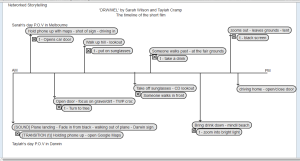Sarah and I began the planning of our networked storytelling film by brainstorming an idea I had brought to her. I had thought that creating a story of our point of view during the day would be an accessible and fun option for the project. Sarah agreed, but thought that a ‘choose your own adventure’ story created through the use of Youtube buttons wouldn’t allow our film to flow comprehensibly. After spending some time discussing and brainstorming different ideas for the film, we came to the conclusion that we would create a linear timeline of our days that alternate between our points of view.

The above screenshot illustrates the timeline Sarah and I compiled for our film. The timeline begins in the morning moving into night, with each event appearing in chronological order; however, from an event that takes place during my point of view, will be followed by an event that takes place during Sarah’s day. The timeline follows a linear pattern, that alternates between Darwin and Melbourne.

The Mockingbird screenshot above illustrates the linear structure of the timeline of our film and furthermore, depicts how our networked story is viewed on-screen by the audience.
Sarah had filmed all of her shots at Camp Boogie in Tallarock, Victoria on her iPad and iPhone, whereas I had filmed throughout Darwin’s, Northern Territory, rural areas and CBD on my Sony HDR-CX240E Handycam. The difference of the cameras used to film our networked story is noticeable throughout the short film as Sarah’s shots do have a vertical boarder either side; however, this is due to the way the shots were imported onto my computer (that isn’t an Apple device). The difference noticeable in the shots does not take away from the overall effect of our short film, instead it reinforces to the audience the change from Sarah’s point of view to mine.
To put together our networked story, I thought it was best for us to use Windows Live Movie Maker – as simple as it is to use. After importing and arranging our shots into the order we had planned in our timeline (pictured above), Sarah thought it would make for a better film if we muted our shots but had the sound effects of each audible to the audience. I genuinely agreed, and decided that the shots with the sound effects we had already recorded would have their volume turned up louder than the music playing in the background for ambiance – Mikhael Paskalev’s ‘I Spy’. During our short film the sounds of car doors opening and closing, a tropical environment, footsteps, wind, a tent zip and the sound of a car driving can all be heard in our recordings in their respective shots. The beginning of our networked story, however, after the appropriate title ‘Darwin-Melbourne’, is the sound affect of an airplane landing which I downloaded from Freesound and shortened its duration using Audacity (pictured below).
When putting the film together, however, problems with the video formats of both Sarah’s and my shots were encountered. The .mov (Sarah’s video format) and .mts (my video format) were not compatible with the 2012 version of Windows Live Movie Maker we were using. The program continued to alert us to delete the files. To solve this, I used a free online video converter to convert the files from their original formats to the general .mp4 format I knew Windows Live Movie Maker would be compatible with.
Sarah and I worked together cooperatively and effectively to produce our networked storytelling. We designed our film so it would begin with my point of view of landing at Darwin airport, transitioning to Sarah’s point of view arriving at Camp Boogie by slightly and quickly blurring my shot of opening Google Maps on my phone to Sarah looking at her map on her phone. Sarah’s view of arriving at Tallarock and opening her car door is transitioned back to my view arriving at a rural Darwin area through a wipe to the right and the opening of my car door. A blur (through a black screen) transitions back to Sarah overlooking the atmosphere of Camp Boogie. The end of this shot, however, shows Sarah putting on her sunglasses which transitions back to me taking mine off. A diagonal sweep to the right transitions the audience back to Sarah’s view of the bands and people at the camp grounds, whilst the end of this shot illustrates Sarah taking a drink. My point of view is transitioned back to as I take a drink, copying Sarah. A wipe to the right transitions back to Sarah leaving Camp Boogie, crawling into a tent to spend the night. Sarah’s final shot fades out to black to fade into my final shot of the view of streetlights diminishing whilst driving home – finishing off my day.

One thought on “Networked Storytelling”